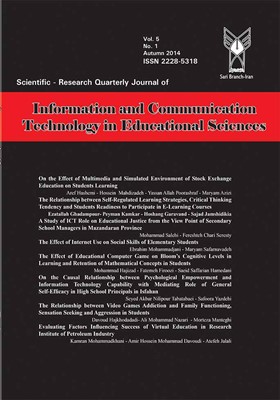بررسی نقش فن آوری اطلاعات و ارتباطات بر عدالت آموزشی از دیدگاه مدیران مدارس دوره متوسطه استان مازندران
الموضوعات :
محمد صالحی
1
 ,
فرشته چاری سرستی
2
,
فرشته چاری سرستی
2
1 - دانشیار گروه علوم تربیتی، دانشگاه آزاد اسلامی واحد ساری، ساری، ایران
2 - کارشناس ارشد مدیریت آموزشی، دانشگاه آزاد اسلامی واحد ساری، ساری، ایران
تاريخ الإرسال : 08 الأربعاء , صفر, 1435
تاريخ التأكيد : 15 الأربعاء , رجب, 1435
تاريخ الإصدار : 08 السبت , محرم, 1436
الکلمات المفتاحية:
فن آوری اطلاعات و ارتباطات,
عدالت آموزشی,
یادگیری فردی,
یادگیری محیطی,
ملخص المقالة :
این پژوهش، با هدف بررسی نقش فنآوری اطلاعات و ارتباطات بر عدالت آموزشی از دیدگاه مدیران مدارس دوره متوسطه استان مازندران انجام شد. روش پژوهش توصیفی، از نوع زمینهیابی بود. جامعه آماری، شامل کلیه مدیران مدارس متوسطه استان مازندران میباشد. حجم نمونه با استفاده از جدول کرجسی و مورگان 238 نفر تعیین شد. روش نمونهگیری تصادفی طبقه ای بر حسب جنسیت بود و بدین ترتیب، 149 نفر زن و 89 نفر مرد به عنوان نمونه انتخاب شدند. ابزار جمعآوری اطلاعات، شامل پرسشنامه 40 سؤالی است که نقش فنآوری اطلاعات و ارتباطات بر عدالت آموزشی را در چهار بعد توسعه گسترده دسترسی، انعطافپذیری یادگیری فردی، انعطافپذیری یادگیری محیطی و ارایه بازخورد مورد بررسی قرار میدهد. روایی محتوایی پرسشنامه از نظر متخصصان تأیید شد و پایایی آن با استفاده از آزمون آلفای کرونباخ، 0/82 محاسبه شد. داده های جمعآوری شده با استفاده از آزمون تی تکنمونهای مورد بررسی قرار گرفت. نتایج نشان داد که فنآوری اطلاعات و ارتباطات از طریق توسعه گسترده دسترسی، انعطافپذیری کردن یادگیری فردی، انعطافپذیری کردن یادگیری محیطی و ارایه بازخورد فوری بر عدالت آموزشی نقش داشته است.
المصادر:
Abdoos, M. (2002). Effective factors in inequality educational opportunities between girls and boys. Summary of Engineering Theses Revisions in the General Education, Tehran: Education Research Center. (in Persian).
Afsheh, A., Kianfar, F., & Shaeidi, A. (2011). Assessing the application of information technology in education and its influence on productivity in Islamic Azad University. Magazine of E-learning Distribution in Academy (MEDIA), 2(1), 2-11. (in Persian).
Atkinson, R. D., & McKay, A. (2007). Digital prosperity: Understanding the economic benefits of the information technology. Retrieved from http://ssrn.com/abstract=1004516
Babadi, A., Sharif, M., & Jamshidian, A. (2007). Provision and development equality of opportunities and educational justice in the general education of Esphahan Province. Social Welfare, 10(37), 287-305. (in Persian).
Benamati, J. (2008). Decision support systems infrastructure: The root problems of the management of changing IT. Decision Support Systems, 45(4), 833-844.
Bennett, C., Both, C., & Yeadle, S. (2001). Mainstreaming equality in the committees of the Scottish Parliament. University of Strathclyde. Retrieved from http://www.scottishparliament.eu/S1_EqualOpportunitiesCommittee/Reports/eo03-mer.pdf
Distefano, A., Rudestam, K. E., & Silverman, R. J. (2004). Encyclopedia of Distributed Learning. California. SAGE Publications.
Golparvar, M. (2010). The relationship between ethic and educational justice with avoiding of fraud. Ethics in Science and Technology, 5(1&2), 57-66. (in Persian).
Golparvar, M., Javadian, Z., & Mosahebi, M. R. (2011). Structural patterns of educational justice relation with satisfied with obtain civil behaviors results-educational and fraud education. New Thinking in Educational Sciences, 7(1), 87-102. (in Persian).
Hajjforosh, A., & Orangi, A. (2004). Results of using information and communication technology in Tehran high schools. Educational Innovation, 3(9), 11-31. (in Persian).
Kaffash, H. (2011). Necessity of product electronic content. Improvement Technical and Vocational Education, 6(4), 8-17. (in Persian)
Miliszewska, L., & Rhema, A. (2010). Towards e-learning in higher education in Libya. Informing Science and Information Technology, 7(1), 423-437.
Mohammadi, M. A., & Dehghan, H. (2004). The general education and modern discourse. Tehran: Education Research Center. (in Persian).
Ranaii, M. (2006). Survey Effect of ICT on educational justice in point of high school headmasters view of Tehran. M.A. Thesis, Educational Sciences and Psychology Collage, Shahid Beheshti University of Tehran. (in Persian).
Samadi, S., Golmohammadi, A., & Khosravi, E. (2012). Educational justice in police forces learners. Development, 7(25), 79-90. (in Persian).
Sanagoo, A., Nomali, M., & MahastyJuybari, L. (2011). Explaining educational justice in medical science students. Horizon of Medical Education Development Journal, 4(3), 39-44. (in Persian).
Shojaiipoor, Sh. (2004). IT and virtual education (challenges and procedures). Research Center of Information and Communication Technology. (in Persian).
Sorkh, E. (2007). Educational inequality and environmental inequality based on ethnic aspect. Education, 3, 103-124. (in Persian).
Tezci, E. (2010). Attitudes and knowledge level of teachers in ICT use: The case of Turkish teachers. International Journal of Human Sciences, 7(2), 21-32.
Villanueva, C. L. (1999). Technology in education: Meeting future challenges. Fifth UNESCO-ACEID International Conference on Education. Bangkok, Thailand, 13-16 December. Retrieved from http://www2.unescobkk.org/elib/publications/ aceidconf5/aceidconf5.pdf
Yazdani, E. (2010). The role of information technology in education. Abstract of Mazandaran Theses, Babol: Honar Altahrir Publications. (in Persian).
Yazdani, E. (2010). The role of information technology in education. Abstract of Mazandaran Theses, Babol: Honar Altahrir Publications. (in Persian).
![]() ,
فرشته چاری سرستی
2
,
فرشته چاری سرستی
2


